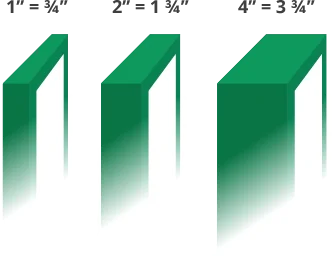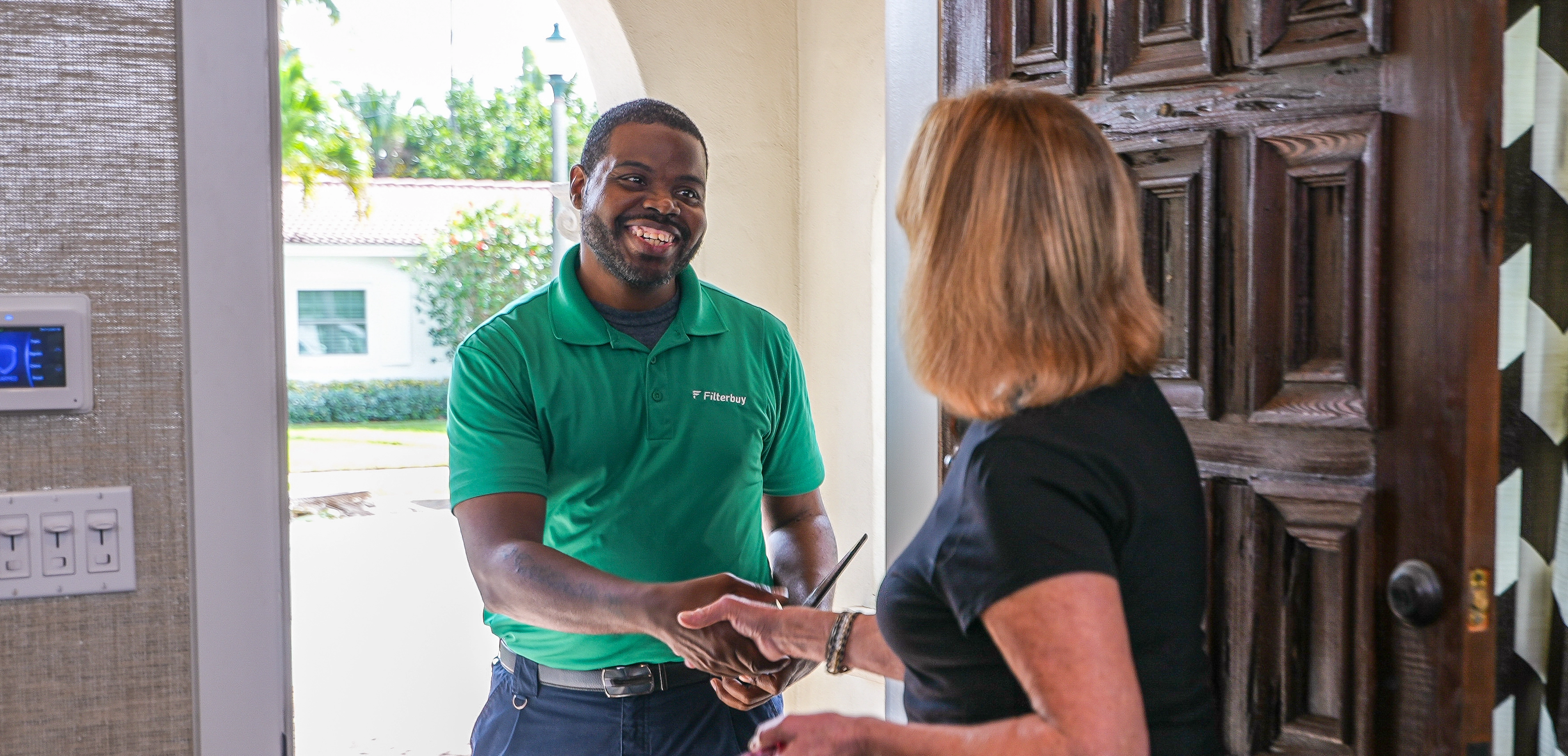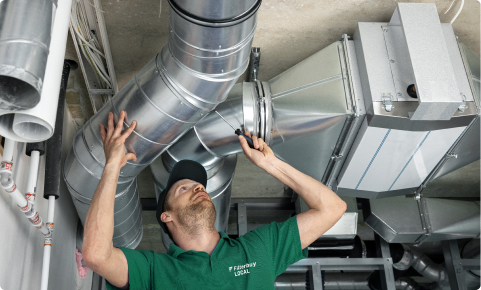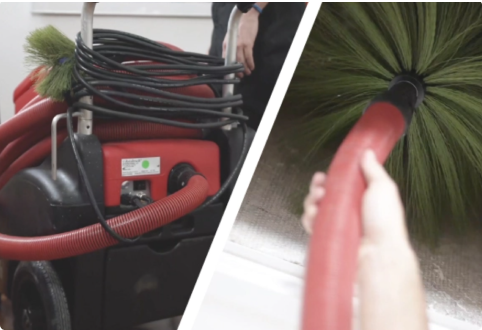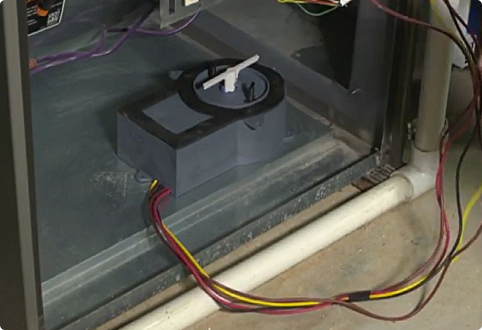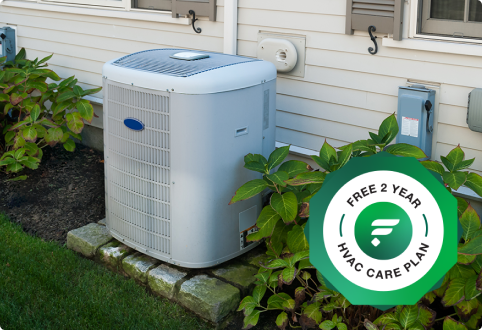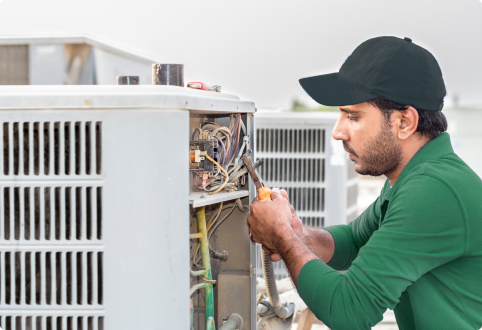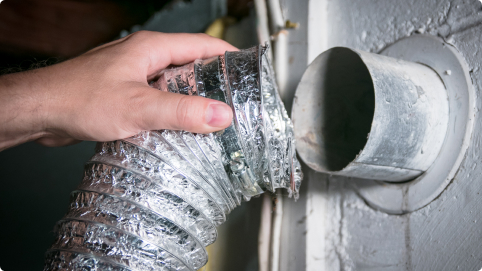Welcome to Filterbuy Local, the best HVAC air ductwork repair service company proudly serving in and near the greater Port St Lucie, FL area. Please let us know how we can help solve your Port St Lucie HVAC air duct repair needs with professional, affordable, and fast residential and commercial HVAC services by getting a free online quote or by giving our friendly HVAC specialists a call. We look forward to hearing from you!
HVAC Air Ductwork Repair Services Port St Lucie FL
Homeowners in Port St Lucie, FL face various HVAC issues that require specialized repair services. One of the most demanding and complex problems is air ductwork repairs. In this article, extensive details are provided regarding the different kinds of HVAC air ductwork repair services available to homeowners in Port St Lucie and their importance for maintaining a healthy living environment.
Air ductwork systems are an integral part of any home's heating, ventilation, and cooling (HVAC) system. The primary purpose of these units is to provide conditioned air circulation throughout all areas of a residence or commercial building. When properly installed and maintained, they ensure that temperature-controlled air circulates evenly throughout the property to maintain comfort levels indoors. Unfortunately, due to its complexity and constant exposure to dust and other particles, air ducts often become clogged with debris which can lead to poor indoor air quality as well as increased energy costs from inefficient operation if not addressed promptly.
Homeowners in Port St Lucie need to have access to reliable professionals who specialize in providing high-quality HVAC Air Ductwork Repair Services. This article will discuss the range of repair services offered by experienced contractors operating within the area as well as explore why residents need to make sure their home’s central heating and cooling system remains efficient at all times.
Definition Of HVAC
Heating, Ventilation, and Air Conditioning (HVAC) is a system used in buildings to regulate the temperature inside. It consists of three main components: heating, ventilating, and air conditioning. Heating refers to the production of warm air through various sources such as radiators or boilers; ventilation involves providing fresh outdoor air into interior spaces without compromising thermal comfort; and cooling ensures indoor temperatures remain comfortable by using methods such as evaporative coolers or refrigeration systems. Depending on the climate and building design, HVAC systems are designed accordingly for optimal performance.
The next component of an HVAC system is ductwork which helps circulate heated or cooled air throughout the space evenly. Ducts are usually made from metal materials like galvanized steel but may also be found constructed with plastic or other composite materials. The shape of ducts can vary depending on their purpose - round for supply air and rectangular for return air - while some designs are more complex than others, incorporating multiple bends and turn to reach every corner of the room. Properly installed and maintained ductwork ensures effective airflow within a space while protecting against dust build-up over time due to poor maintenance or improper installation.
Air duct repair services provide preventative maintenance that helps reduce energy costs associated with operating an inefficient system. These services often involve inspecting existing ductwork for leaks and cracks, replacing aging parts when necessary, resealing joints to improve insulation values, testing combustion safety devices on furnaces, and performing air filter changes regularly among many other tasks aimed at keeping your HVAC system running efficiently year after year. With proper maintenance come lower monthly bills as well as improved indoor air quality in any residential or commercial setting.
Benefits Of Air Ductwork Repair
Maintaining an HVAC system can be compared to maintaining a car, like ensuring all its parts are in working order and taking it for regular servicing. Just as regular oil changes help keep the engine running smoothly, proper maintenance of air ducts ensures these systems remain efficient over time. Air duct repair services offer numerous benefits that can improve indoor comfort while reducing energy costs.
The first advantage is improved airflow within a space due to sealed joints and properly connected components. This not only helps maintain comfortable temperatures throughout but also reduces strain on the HVAC unit itself since it doesn’t have to work as hard to achieve desired results. In addition, regularly inspecting and cleaning out dust buildup from air ducts improves indoor air quality by eliminating allergens or debris which may trigger breathing problems such as asthma or allergies in some people. Furthermore, well-maintained ductwork increases efficiency when heating or cooling a building, leading to lower monthly bills due to reduced energy consumption.
Overall, there are many advantages associated with having your HVAC system serviced regularly which leads to better performance and more cost savings down the line. By investing in preventative measures today, you will enjoy long-term benefits tomorrow. Taking this step now will ensure you experience optimal comfort levels indoors year-round without worrying about skyrocketing utility bills or poor air quality indoors. With that said, let's take a look at some types of repairs offered by professional technicians specializing in HVAC systems and their respective components.
Types Of Repairs Offered
When it comes to air duct repairs, there are a variety of services offered by experienced professionals. These may include sealing duct joints and connections, replacing filters or other parts, balancing airflow between different areas in the home, and re-insulating ducts that have been exposed due to wear and tear over time. Additionally, technicians can inspect for signs of mold growth or water damage within the system which is important for preventing potential health risks associated with these contaminants. Moreover, experts may also provide advice on how best to maintain your HVAC system for optimal performance such as scheduling regular cleanings throughout the year.
In addition to repairing existing systems, many companies offer installation services if you are looking to upgrade from an older model or need a full replacement. This includes selecting the right size unit given space limitations as well as determining what type of venting needs to be done depending on where the new unit will be placed inside the building. Furthermore, they can help identify any insulation requirements needed along with any additional components like exhaust fans that might be necessary for the proper functioning of the device.
Overall, having skilled technicians perform repair and maintenance services on your HVAC system not only ensures it works properly but also helps save money in energy costs while improving indoor comfort levels overall. Moving forward, we will look at some common tools and technologies used when conducting these types of jobs so you can better understand the process involved in keeping your air ducts operating efficiently.
Tools And Technologies Used
From the simplest of repairs to the most complex installations, skilled professionals rely on a range of tools and technologies to ensure quality work is done promptly. Like any job, having the right equipment for the task at hand can make all the difference between success and failure; this rings true when it comes to HVAC air ductwork repair services. To that end, let's take a closer look at some of these essential items:
1) Pressure Gauges: These devices are used to measure suction and discharge pressures within an HVAC system which helps identify any issues with airflow distribution or blockages in the ducts. This information then provides technicians with insight as to how best to address such problems before they become worse.
2) Digital Thermometers: With digital thermometers, specialists can get accurate readings on temperature levels throughout various points around the home so they can assess whether or not a unit is functioning optimally. Additionally, if needed new insulation may be installed depending on where these measurements were taken from and what type of climate control needs exist.
3) Duct Cleaners: Specialized cleaning machines are designed specifically for removing dirt and debris buildup inside air vents which should be conducted regularly for optimal performance. Moreover, these vacuums also help reduce allergy symptoms associated with dust mites and other allergens commonly found inside homes over time.
4) Air Flow Anemometers: By using airflow anemometers, experts can check static pressure drop through registers while balancing out fan speeds across different areas so overall functionality improves without wasting energy resources unnecessarily along the way.
As we have seen, there are multiple pieces of technology involved in ensuring that your HVAC units remain running properly; however, just as important as having access to these materials is making sure you hire qualified personnel who understand their use. In our next section, we will discuss what factors to consider when looking for someone proficient in conducting air duct repairs given their importance in maintaining healthy indoor environments year-round.
Professionalism And Expertise
When it comes to HVAC air ductwork repair services, professionalism, and expertise should be of the utmost importance. A qualified technician will not only have a comprehensive understanding of the tools and technologies used in the industry but also possess the necessary skill sets to address any issues that may arise. Here are some key traits to consider when looking for an expert:
First, they should have had prior experience working on HVAC systems as this ensures they know how to diagnose problems accurately and solve them efficiently. Additionally, those with certifications from accredited organizations such as NATE or ROSES are even more desirable since these demonstrate their commitment to ongoing education which is essential in staying up-to-date with advances in technology.
Second, good customer service is equally important; someone who takes time to explain each step involved during repairs as well as answer any questions you might have along the way will ensure you feel comfortable throughout the process. Furthermore, if there’s something specific you’d like done then make sure your chosen professional can accommodate these requests so expectations are managed appropriately right off the bat.
Finally, proper safety protocol must always be followed regardless of what type of work needs to be done; protective gear should be worn at all times while electrical devices stay disconnected until everything has been inspected thoroughly firsthand. This is especially true when dealing with older homes where hazardous materials could potentially exist behind walls or underneath floorboards without being visible from sight initially.
With all this information now readily available, homeowners can rest assured knowing that finding a reliable contractor for their next HVAC project is just around the corner. To move forward, however, cost estimation and payment options need to be discussed beforehand so let's take a look into exactly what this entails next.
Cost Estimation And Payment Options
Before any work can commence, it is important to discuss cost estimation and payment options. The first step would be to acquire a detailed quote from the contractor outlining all prospective services that need to be completed along with their respective costs. This allows homeowners to review each item closely so they know exactly what they’re signing up for ahead of time.
It is also worth noting that certain HVAC repair companies may offer discounts or financing plans depending on individual circumstances; they might even include free estimates as part of their initial proposal if requested. In either case, though, remember to always double-check and confirm the total amount before committing since unexpected fees could come into play further down the line otherwise.
Once everything has been agreed upon in writing, payment should then take place via credit card or bank transfer - both are usually accepted by most contractors nowadays although cash payments remain an option too if preferred. It's important however that customers receive a receipt after making their purchase which serves as evidence of transaction completion in case anything goes wrong afterward.
Timeframe For Completion
With the financial side of things taken care of, the next step is to obtain an estimated timeframe for completion. This can vary widely depending on the scope of work involved and should always be discussed beforehand to avoid any unwanted delays or misunderstandings. Contractors who are experienced in HVAC repairs will usually provide a timeline that takes into account both their schedule as well as local weather conditions so homeowners can rest assured knowing when they should expect results.
Furthermore, certain circumstances such as access to parts may also affect how long it takes for services to finish; in which case customers should ask if there’s anything else they need to do to help expedite matters - this could include ordering specific components ahead of time or simply getting ready for installation day by ensuring all necessary tools are available at hand.
Once everything has been finalized, the contractor will then begin working towards delivering results within agreed-upon timelines while keeping customers up-to-date throughout the entire process until complete satisfaction is achieved.
Quality Assurance Guarantee
To ensure customer satisfaction and guarantee a high-quality job, reputable HVAC contractors will provide a quality assurance guarantee. This means that the contractor is vouching for their workmanship and stands by it in case of any issues or problems after completion. Additionally, these guarantees often include parts as well so customers can rest assured knowing they are covered if something were to go wrong with installation components down the line.
Moreover, experienced technicians should be able to explain the limitations of their services and what repairs would be necessary to remedy potential issues - this can help homeowners save time and money on future maintenance costs. Furthermore, warranties may also cover periodic inspections which should help identify small hiccups before they turn into bigger repair bills later on.
In addition to guaranteeing quality results, professional contractors will take extra steps such as using appropriate safety equipment when handling hazardous materials like refrigerant gasses - all of which adds another layer of protection for both workers and clients alike.
Safety Precautions Taken
When it comes to HVAC air ductwork repair services, safety is paramount. To ensure the safety of both clients and contractors, experienced technicians take several precautionary measures when onsite. This includes wearing appropriate protective gear such as respirators, gloves, and goggles to protect against hazardous materials like dust particles or refrigerant gasses that may be present during repairs.
In addition to personal protection equipment (PPE), reputable technicians will also use specialized tools designed specifically for handling these substances safely. Furthermore, they are trained to identify potential issues before beginning work so that any risks can be mitigated before starting the project. This helps prevent accidents while ensuring all necessary protocols have been followed throughout installation or maintenance processes.
Beyond physical safety precautions though, professional HVAC contractors understand their responsibility in safeguarding client information - whether it's financial data associated with billing or sensitive customer details stored within company records. As such, reliable companies employ secure encryption technologies which further protect customers from identity theft and other cyber threats.
Customer Reviews And Testimonials
It is always important to thoroughly research any HVAC air ductwork repair services before selecting a contractor. This includes reviewing customer reviews and testimonials, as these provide helpful insight into the quality of service offered. Positive feedback from satisfied customers can signify that a company provides reliable repairs and installations in addition to excellent customer service. However, if there are numerous complaints about problems such as delayed completion times or poor workmanship, this may be an indication that the contractor should be avoided.
In some cases, companies will also offer free estimates for potential projects or have their technicians inspect existing units for maintenance purposes. This allows clients to gain additional knowledge about the condition of their system and weigh costs accordingly before hiring a provider. Additionally, many contractors will include warranties with their services to clients feel secure knowing they are covered if something goes wrong during the installation or repair process.
It is therefore essential when considering HVAC air ductwork repair services to review all available information which includes both customer reviews and any related guarantees offered by providers. Doing so can help ensure clients select the best possible option for meeting their needs while providing peace of mind throughout the project.
Frequently Asked Questions
How Often Should Air Ducts Be Inspected?
Air ducts are an essential part of any residential or commercial building, providing airflow and ventilation to interior spaces. Inspecting the condition of these ducts is key to ensuring optimal performance for their intended purpose. But how often should this inspection take place?
The answer depends on several factors such as location, usage, and age of the system. Location can play a role in determining the frequency of inspections due to external environmental conditions that may affect the integrity of the ductwork over time. Usage can also determine how frequent inspections must happen; if the space has high traffic volumes with significant temperature changes then more frequent checks will be needed than those used less regularly. Age is another important factor; newer systems require fewer assessments while older ones need more regular check-ups to make sure they remain operational.
In general, it's recommended that air ducts are inspected every three years or so to ensure the proper functioning of HVAC systems. However, depending on other criteria mentioned previously, some buildings may require additional attention sooner rather than later. Regardless, professional contractors specializing in HVAC services should be contacted when necessary since they have experience and knowledge regarding what type and level of maintenance is required at different intervals for various types of air ducts.
What Additional Maintenance Can I Do To Keep My Air Ducts In Good Condition?
Maintaining air ducts is a key component to keeping HVAC systems running efficiently. One of the most important aspects of maintaining these ducts is performing regular inspections and additional repairs as needed. In addition to this, there are other maintenance tasks that homeowners can take on to keep their air ducts in good condition.
One such task involves cleaning out any dirt or debris which may have accumulated within the system over time. This should be done regularly and thoroughly to ensure that nothing gets stuck inside the ductwork or clogged up in the filters. Additionally, it is also recommended that insulation around the outside of the system be checked periodically for signs of damage or wear and tear. If necessary, repairs should be made promptly so as not to affect efficiency levels.
Finally, another suggested measure when attempting to maintain an efficient HVAC system is to inspect all vent covers throughout the home for proper alignment and installation. Improperly-aligned vents can increase energy costs due to inefficient airflow, leading to poor temperature control within certain rooms of the house. Therefore, these components must be routinely inspected and adjusted accordingly if need be.
Are There Any Health Risks Associated With Air Ducts?
Air ducts are an important part of any HVAC system, and understanding their potential health risks is essential. This discussion will focus on the possible health risks associated with air ducts, including a list of three key points to consider.
First, it is important to understand that although proper maintenance can help reduce dust buildup in air ducts, there may still be instances in which contaminants remain airborne inside the home or building. These contaminants could include mold spores from water damage inside the air ducts, dander from pets, and even hazardous materials such as asbestos fibers found in some older systems. All of these substances have the potential to affect human health when inhaled over time.
Second, inadequate insulation around air ducts can result in increased energy costs due to heat loss and cold drafts throughout your home or business space. Poorly insulated ductwork can also cause condensation problems and lead to increased moisture levels within the interior environment — conditions that promote mold growth and other biological organisms like bacteria, fungi, pollen, and viruses circulating through the air you breathe.
Finally, damaged or leaking air ducts can cause hot spots or chilly areas throughout your home by allowing heated or cooled air to escape into wall cavities instead of being directed toward its intended destination — resulting in inconsistent temperatures at various locations within your living space. Not only does this make for uncomfortable indoor temperatures but it increases energy consumption as well since more conditioned air is required to cool down (or warm up) certain parts of a room than others; making heating/cooling bills higher overall.
When considering whether there are health risks associated with air ducts one should take into account:
1) The presence of potentially harmful airborne contaminants;
2) Potential issues caused by inadequate insulation;
3) Possible temperature inconsistencies created by leaky or damaged ductwork.
Taking steps to ensure proper installation and regular maintenance of your HVAC system's air ducts helps minimize these risks while maintaining healthy indoor environments capable of providing comfort year-round without excessive energy costs.
What Additional Services Are Offered In Addition To Air Duct Repair?
When it comes to air duct repair, several additional services can be provided in addition to the actual repair. These supplementary services may include cleaning and inspection of ducts, installation or replacement of components such as filters, and even re-insulation. All these measures help ensure the proper functioning and performance of the HVAC system overall.
Furthermore, specialized services like sealing leaks provide an added layer of protection for both safety and efficiency purposes. Such leak sealing helps reduce energy costs by preventing outside air from entering the system through any gaps or cracks in the ductwork. Additionally, this type of service is essential for avoiding health risks associated with mold growth due to moisture infiltration into the system.
To get maximum value out of their investment in air duct repairs and related services, customers should consider engaging experienced professionals who can accurately assess all elements necessary for optimal results. This includes conducting detailed inspections before starting any repairs or installations so that all potential problems are identified ahead of time and addressed appropriately.
Are There Any Environmental Considerations When Repairing Air Ducts?
Investigating the environmental considerations when repairing air ducts is an important task. In any service that involves repairs, it is essential to consider the potential impact on both people and the planet alike. With this in mind, let us start by reflecting on what needs to be taken into account when a repair job requires attention.
Firstly, assessing the materials used for maintenance and whether they are suitable for use indoors is paramount; not only must these components be safe for human contact but also non-toxic and eco-friendly for the environment as well. Additionally, determining if there are any emissions of pollutants associated with the work being done can help reduce hazardous waste from entering our atmosphere. Furthermore, using recycled products where possible will significantly decrease energy consumption during production processes – resulting in decreased carbon footprints all around.
The implementation of proper ventilation systems should also be considered before performing any repairs as having adequate airflow helps ensure good indoor air quality while reducing exposure to pollutants such as dust mites and mold spores. Finally, ensuring that all safety regulations are followed throughout each step of the process will minimize risks associated with improper handling of hazardous materials or faulty machinery operation.
By taking into account all environmental factors before commencing a repair job, one can rest assured knowing that their actions have been mindful towards preserving our world today and tomorrow.
Is it worth it to replace air ducts?
Yes, it can be worth it to replace air ducts, especially if they are old, leaking, or inadequately insulated. Over time, air ducts can develop leaks and holes leading to significant energy loss. Additionally, ductwork that is not properly insulated can also lead to energy inefficiency. By replacing your ductwork, you can improve the overall efficiency of your HVAC system, which can lead to lower energy bills. Moreover, new ductwork can also improve indoor air quality by reducing the amount of dust, allergens, and other contaminants that can accumulate in old ducts.
How do you fix torn ductwork?
Fixing torn ductwork often involves a few steps. Initially, the damaged area must be thoroughly cleaned to remove any dust or debris. Then, a mastic sealant or metal tape (not duct tape, surprisingly) is applied to the tear to seal it off. In some cases, a piece of sheet metal may be used as a patch, fastened over the torn area, and sealed around the edges. While minor damage can often be repaired by homeowners, significant damage or wear may require the services of a professional.
How often should home air ducts be replaced?
The frequency of replacing home air ducts can vary greatly depending on several factors. This includes the quality of the initial installation, the type of ductwork used, and the conditions within the home. However, as a general guideline, air ducts may start to show signs of wear and tear and need replacement after about 15 to 20 years. Regular maintenance and inspections can help to extend the lifespan of your ductwork.
How long does ductwork last in Florida?
In a state like Florida, where the climate is both hot and humid, ductwork can often face additional stresses. This can sometimes result in a slightly shorter lifespan, often around 10 to 15 years. However, with good maintenance and regular inspections, it's possible for ductwork in Florida to last much longer.
Should 30-year-old ductwork be replaced?
If your ductwork is 30 years old, it may indeed be time to consider a replacement. Over time, ductwork can become less efficient due to leaks, holes, and poor insulation. Additionally, older ductwork can often accumulate dust, allergens, and other contaminants that can affect air quality. Therefore, replacing your ductwork can improve both your home's energy efficiency and indoor air quality.
What is the life expectancy of ductwork?
The life expectancy of ductwork can vary based on some factors such as the type of material used, the quality of the installation, and the conditions within the home. However, generally speaking, well-installed and maintained ductwork can often last between 15 to 20 years.
Why is ductwork so expensive?
Ductwork can be expensive due to several factors. It is a specialized job that requires skilled labor and the materials used can also be quite costly. Additionally, the process of installing or replacing ductwork can be time-consuming, particularly if the ducts are located in hard-to-reach areas of the home. This can drive up labor costs.
How hard is it to replace ductwork?
Replacing ductwork can be a challenging task, particularly for those without experience in HVAC work. It requires knowledge of heating and cooling systems, as well as the ability to work in tight and often uncomfortable spaces. Moreover, incorrect installation can lead to inefficiencies and future problems. Therefore, while a motivated homeowner can replace their ductwork, it's often a job best left to professionals.
Should I seal or replace the ductwork?
Whether you should seal or replace your ductwork can depend on the extent of the damage or wear. If the ductwork has small leaks or tears, then sealing may be sufficient. However, if there is significant damage, or if the ducts are old and poorly insulated, then replacement may be the better option. It's also worth considering that while sealing is less expensive upfront, over time, the energy savings from having new, more efficient ductwork could offset the cost of replacement.
How do I know if I have bad ductwork?
There are several signs that you may have bad ductwork. These can include high energy bills, uneven heating or cooling in different rooms, excessive dust in your home, and noticeable noises from your ductwork like rattling or hissing. Additionally, if your ductwork is old, it may be worth having it inspected for any signs of wear or damage.
Is metal ductwork better than flex?
Both metal and flex ductwork have their pros and cons. Metal ductwork is generally more durable and less likely to be damaged. It also tends to be more efficient as it doesn't sag or kink, which can restrict airflow. However, flex ductwork is generally easier and quicker to install, which can reduce labor costs. It's also better at absorbing sound, which can make your HVAC system quieter.
Should I replace ductwork in an old house?
In an old house, the ductwork may be outdated or damaged, which can lead to energy inefficiency and poor indoor air quality. Therefore, if the ductwork in your old house is showing signs of wear, or if you're experiencing problems like uneven heating or cooling, high energy bills, or poor air quality, it may be worth considering replacement.
Conclusion
Air ducts are an essential part of any home’s HVAC system and require regular maintenance. Inspecting air ducts every few years will ensure that they remain in good condition, and additional measures can be taken to further protect them from wear and tear. While some health risks may exist when dealing with old or damaged air ducts, the risk is minimal if proper precautions are taken. There is a wide range of repair services available for all kinds of air duct systems, as well as options for those looking for more comprehensive solutions. It’s also important to consider the environmental impact of repairing air ducts before making any decisions about repairs.
The importance of maintaining one's air duct system cannot be overstated; it ensures safe airflow throughout the house while providing climate control and protection against allergens, dust, and other particles in the environment. To keep their air clean and healthy, it is necessary to inspect these components regularly and take steps to fix any issues quickly. Air duct repair services provide peace of mind by ensuring that homeowners have access to qualified professionals who understand how best to maintain their HVAC system safely and effectively.
In many ways, caring for one's air duct system is akin to taking care of a beloved pet: both require regular maintenance, attention, and love for them to thrive in their environment. In addition to being aware of potential health concerns associated with neglected or faulty air ducts, it pays off handsomely in terms of comfort level indoors when these vital elements are kept properly maintained through professional inspection services such as those offered at Port St Lucie FL. By investing time into understanding what needs to be done now –and what might need to be done down the road– homeowners can enjoy cleaner indoor air without worrying about costly unexpected repairs due to neglecting this integral component of their home's HVAC system.
Here is the nearest branch location serving the Port St. Lucie area…
Filterbuy HVAC Solutions - West Palm Beach FL
1655 Palm Beach Lakes Blvd ste 1005, West Palm Beach, FL 33401
(561) 448-3760
https://maps.app.goo.gl/RBfjJ4u9fg8d7mes6

.webp)
.webp)
.webp)
.webp)
